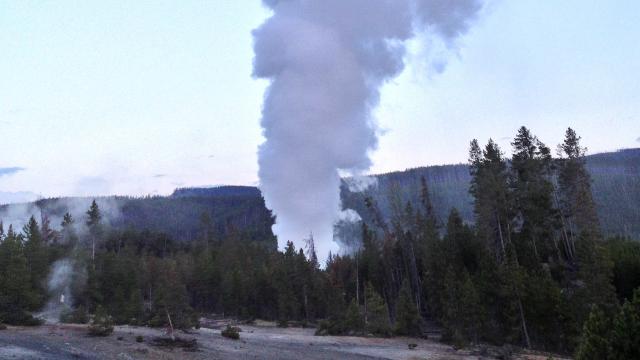Yellowstone National Park is probably not about to erupt in an explosion that could wreck the immediate area and flood the state of Wyoming with ash, despite several “unusual” eruptions at the world’s largest active geyser over the course of the past few weeks.
Steamboat Geyser at Norris Geyser Basin in Yellowstone National Park, Wyoming, in 2013.Photo: AP
Per Reuters, scientists say that there is no sign the increased frequency of eruptions at Steamboat Geyser is an indication the Yellowstone caldera — a massive volcanic crater formed by the last of three super-eruptions in the region from 2.1 million to 630,000 years ago — is about to blow:
Steamboat Geyser, which can shoot water as high as 91m into the air, erupted on March 15, April 19 and on Friday. The last time it erupted three times in a year was in 2003, the US Geological Survey’s Yellowstone Volcano Observatory said.
The last time it erupted prior to March was more than three years ago in September 2014.
“There is nothing to indicate that any sort of volcanic eruption is imminent,” Michael Poland, the scientist in charge for the observatory, said in an email.
According to the Bozeman Daily Chronicle, the Steamboat Geyser eruption on Friday was reported by a park visitor and was estimated to have begun at 6:30 am; that person was likely the only one who witnessed it firsthand, since boardwalks leading to area are closed due to high snowfall.
Poland told Reuters the two April eruptions were smaller than usual at the geyser, but did eject approximately 10 times more water than Old Faithful, the park’s most famous geyser. He added that geysers erupt sporadically and that the distribution of the latest events may simply reflect “randomness.” A real indication of serious danger would be if the underground hydrothermal systems beneath the park dried up, which would indicate magma was getting closer to the surface, Reuters added.
While it’s been 70,000 years since the last major lava event in Yellowstone, the region is still very much active and poses the potential to erupt at some point in the future, perhaps disastrously. Per the Washington Post, an event in Yellowstone could be thousands of times more powerful than the Mount St. Helens explosion in 1980; the United States Geological Survey predicts that a sufficiently powerful eruption, while unlikely, would leave much of the northern Rockies buried in feet of ash.
Lava flows could cover a radius unlikely to happen in our lifetimes.
Recent computer models have shed some light on the structure of the magmatic system below Yellowstone, though scientists are still far away from predicting future eruptions.
However, Yellowstone Volcano Observatory monitoring arrays would probably detect “sudden or strong movements or shifts in heat that would indicate increasing activity,” the National Park Service writes, and that a “catastrophic” eruption would likely be preceded by weeks to years of warning signs.
[Reuters]
